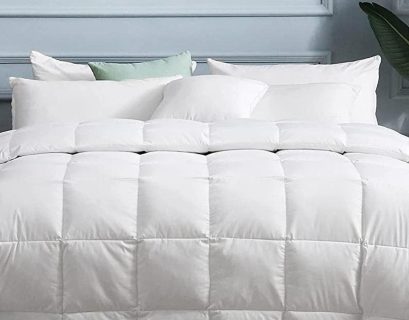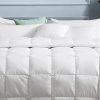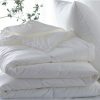As the seasons change, so do our preferences for clothing, activities, and even our bedding. Finding the perfect balance between comfort and temperature regulation is essential for a restful night’s sleep. In this comprehensive guide, we will explore the world of seasonal bedding, discussing the specific types of bedding suitable for different seasons. From lightweight linens for summer to cozy comforts for winter, understanding how to tailor your bedding choices to the climate can significantly enhance your sleep experience.
1. Summer Bedding:
a. Sheets:
- Material: Opt for lightweight and breathable fabrics such as cotton, percale, or linen. These materials promote airflow, preventing overheating during warmer nights.
- Thread Count: Choose sheets with a lower thread count (200-400) for a crisp and cool feel.
b. Blankets:
- Material: Cotton or lightweight, breathable fabrics work well. Consider using a cotton waffle blanket or a lightweight cotton throw for added comfort without excess warmth.
c. Duvets and Comforters:
- Fill Power: If using a duvet or comforter, select a lower fill power to avoid excessive insulation. Down alternatives and lightweight fillings are suitable for summer.
d. Color Palette:
- Opt for lighter colors to reflect sunlight and keep the sleep environment visually cool.
2. Spring and Fall Bedding:
a. Sheets:
- Material: Stick with breathable fabrics like cotton or percale. As temperatures fluctuate, these materials provide a comfortable balance.
b. Blankets:
- Material: Choose versatile blankets made of cotton, fleece, or lightweight wool. These options offer warmth without the heaviness of winter bedding.
c. Duvets and Comforters:
- Fill Weight: Opt for a mid-weight duvet or comforter to accommodate the transitional temperatures of spring and fall. A mix of natural and synthetic fillings can provide the perfect balance.
d. Color Palette:
- Embrace a variety of colors to reflect the changing seasons. Earth tones, pastels, and floral patterns work well.
3. Winter Bedding:
a. Sheets:
- Material: Choose flannel or jersey knit sheets for their insulating properties. These materials trap warmth and provide a cozy feel during colder nights.
b. Blankets:
- Material: Opt for heavier blankets made of wool, fleece, or down to provide extra warmth. Layering with multiple blankets is a practical approach to adjust to varying winter temperatures.
c. Duvets and Comforters:
- Fill Power: Select a higher fill power for duvets and comforters to ensure maximum insulation. Goose down and heavyweight synthetic fillings work well for winter bedding.
d. Color Palette:
- Choose deeper, richer colors to create a warm and inviting atmosphere. Dark blues, reds, and earthy tones are popular choices for winter bedding.
4. All-Season Bedding Options:
a. Sheets:
- Material: Egyptian cotton or high-quality cotton blends provide comfort throughout the year. These materials are breathable in summer and insulating in winter.
b. Blankets:
- Material: Invest in versatile blankets such as cotton or down alternatives that can be comfortably used in different seasons.
c. Duvets and Comforters:
- Fill Type: Consider duvets or comforters with a mix of down and feathers or high-quality synthetic fillings. This combination offers flexibility for both warmth and breathability.
d. Color Palette:
- Choose neutral tones or patterns that can seamlessly blend with different seasonal aesthetics.
Additional Tips for Seasonal Bedding:
- Layering:
- Embrace the concept of layering. Layering allows you to adjust your bedding according to the temperature, adding or removing blankets and comforters as needed.
- Invest in Quality:
- Quality bedding is an investment in comfort and durability. Opt for high-quality materials that withstand the test of time and provide the desired level of comfort for each season.
- Temperature-Regulating Technology:
- Explore bedding with temperature-regulating technologies. Some fabrics and fillings are designed to adapt to your body temperature, ensuring a comfortable sleep environment year-round.
- Rotate Your Bedding:
- Rotate your bedding with the seasons. Store off-season bedding properly to maintain its freshness and quality.
- Pillow Choices:
- Consider using different types of pillows for different seasons. Breathable, cooling pillows are ideal for summer, while warmer, insulating pillows may be preferred in winter.
Conclusion:
Adapting your bedding to the changing seasons is a thoughtful approach to achieving optimal comfort throughout the year. The right bedding can transform your sleep environment, ensuring that you stay cool in summer, cozy in winter, and comfortable during the transitional seasons.
By carefully selecting materials, considering fill types, and paying attention to color palettes, you can create a sleep sanctuary that aligns with the unique characteristics of each season. Embrace the versatility of all-season bedding options and the joy of transforming your bedroom into a haven that reflects the beauty of every season. Your journey to a good night’s sleep begins with bedding that caters to the ever-changing dance of nature outside your window.
























